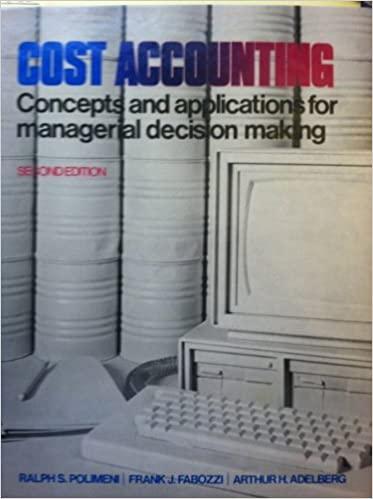The Lorax Electric Company manufactures a large variety of systems and individual components for the electronics industry.
Question:
The Lorax Electric Company manufactures a large variety of systems and individual components for the electronics industry. The firm is organized into several divisions with division managers given the authority to make virtually all operating decisions. Management control over divisional operations is maintained by a system of divisional profit and return on investment measures which are reviewed regularly by top management. The top management of Lorax has been quite pleased with the effectiveness of the system they have been using and believe that it is responsible for the company’s improved profitability over the last few years.
The Devices Division manufactures solid-state devices and is operating at capacity. The Systems Division has asked the Devices Division to supply a large quantity of integrated circuits 1C378.
The Devices Division currently is selling this component to its regular customers at $40 per hundred.
The Systems Division, which is operating at about 60% capacity, wants this particular component for a digital clock system. It has an opportunity to supply large quantities of these digital clock systems to Centonic Electric, a major producer of clock radios and other popular electronic home entertainment equipment. This is the first opportunity any of the Lorax divisions have had to do business with Centonic Electric. Centonic Electric has offered to pay $7.50 per clock system.
The Systems Division prepared an analysis of the probable costs to produce the clock systems.
The amount that could be paid to the Devices Division for the integrated circuits was determined by working backward from the selling price. The cost estimates employed by the division reflected the highest per unit cost the Systems Division could incur for each cost component and still leave a sufficient margin so that the division’s income statement could show reasonable improvement.
The cost estimates are summarized below:

As a result of this analysis, the Systems Division offered the Devices Division a price of $20 per hundred for the integrated circuit. This bid was refused by the manager of the Devices Division because he felt the Systems Division should at least meet the price of $40 per hundred which regular customers pay. When the Systems Division found that it could not obtain a comparable integrated circuit from outside vendors, the situation was brought to an arbitration committee which had been set up to review such problems.
The arbitration committee prepared an analysis which showed that $.15 would cover variable costs of producing the integrated circuit, $.28 would cover the full cost including fixed overhead, and $.35 would provide a gross margin equal to the average gross margin on all the products sold by the Devices Division. The manager of the Systems Division reacted by stating, ‘‘They could sell us that integrated circuit for $.20 and still earn a positive contribution toward profit. In fact,they should be required to sell at their variable cost—$.15—and not be allowed to take advantage of us.”
Lou Belcher, manager of Devices, countered by arguing that, “‘It doesn’t make sense to sell to the Systems Division at $20 per hundred when we can get $40 per hundred outside on all we can produce. In fact, Systems could pay us up to almost $60 per hundred and they would still have a positive contribution to profit.”’
The recommendation of the committee, to set the price at $.35 per unit ($35 per hundred), so that Devices could earn a ‘‘fair’’ gross margin, was rejected by both division managers. Consequently, the problem was brought to the attention of the vice president of operations and his staff.
Required:
What will be the immediate economic effect on the Lorax Company as a whole if the Devices Division were required to supply [C378 to the Systems Division at $.35 per unit—the price recommended by the arbitration committee? Explain your answer. pg369
Step by Step Answer:

Cost Accounting Concepts And Applications For Managerial Decision Making
ISBN: 9780070103108
2nd Edition
Authors: Ralph S. Polimeni, James A. Cashin, Frank J. Fabozzi, Arthur H. Adelberg





